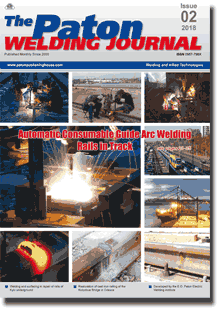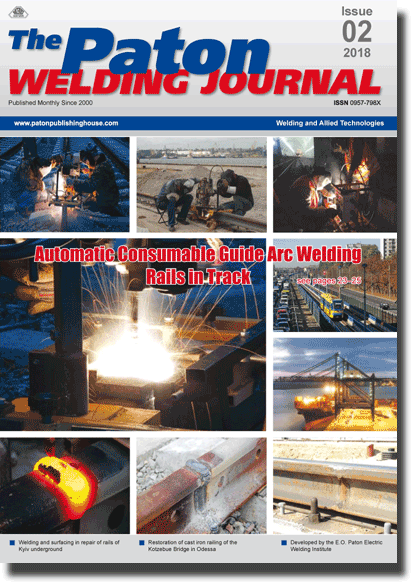Access for download PDF files for subscribers and for reviewers of scientometric bases.
Organization: Elsevier for content access(PDF files of journals released before 2024 are available for download from the website's archives))
Organization: Elsevier for content access(PDF files of journals released before 2024 are available for download from the website's archives))
| 2018 №02 (07) |
DOI of Article 10.15407/tpwj2018.02.08 |
2018 №02 (01) |

The Paton Welding Journal, 2018, #2, 38-41 pages
Electroslag surfacing of billet end faces with application of consumable and nonconsumable electrodes
Yu.M. Kuskov, V.G. Soloviov, P.P. Osechkov and V.V. Osin
E.O. Paton Electric Welding Institute of the NAS of Ukraine 11 Kazimir Malevich Str., 03150, Kyiv, Ukraine. E-mail: office@paton.kiev.ua
Abstract
Producing minimum and uniform penetration of base metal at electroslag surfacing of end faces by consumable electrode of a large cross-section is a complex task. The most promising is the application of nonconsumable electrode – current-supplying mould for these purposes. Influence of different electric circuits of connection of electrodes of different diameter from one or two AC power sources on base metal penetration was studied. It is found that from the viewpoint of optimizing the surfacing technology (achievement of not only quality indices, but also increased process efficiency), it is promising to apply the surfacing circuit with one power source and the same potentials on the bottom plate and current-conducting section of the current-supplying mould. Circuit of electroslag surfacing with two sources allows producing similar results, but it is more complicated to implement (presence of two sources) and less cost-effective, respectively. Obtained results can make up the data bank for designing a system of automatic regulation of base metal penetration at electroslag surfacing of end faces. 11 Ref., 1 Table, 3 Figures.
Keywords: electroslag surfacing of end faces, large cross-section consumable electrode, current-supplying mould, AC power sources, base metal penetration
Received: 15.11.17
Published: 15.03.18
References
- Shvartser, A.Ya., Dorokhov, V.V, Ponomarenko, V.P. (1982) Development of electroslag surfacing method of excavator bucket teeth. In: Modern methods of surfacing and their application. Kiev, PWI, 70–77 [in Russian].
- Kiseleva, I.V., Dorokhov, V.V., Shvartser, A.Ya., Gerasimov, E.A. (1989) Application of electroslag heating in hardening restoration surfacing of excavator bucket teeth. Problemy Spets. Elektrometallurgii, 3, 28–30 [in Russian].
- Ponomarenko, V.P., Shvartser, A.Ya., Stroganova, G.V. (1985) Examination of fusion zone of high-chromium cast iron with high-manganese steel in electroslag surfacing. Metallovedenie i Term. Obrabotka Metallov, 11, 55–58 [in Russian].
- Kiseleva, I.V., Dorokhov, V.V., Schvartser, A.Ya., Gerasimov, E.A. (1989) Regulation of extension of transition zone by electroslag heating method. Problemy Spets. Elektrometallurgii, 4, 15–19 [in Russian].
- Kuskov, Yu.M., Soloviov, V.G., Zhdanov, V.A. (2017) Electroslag surfacing of end faces with large-section electrode in current-supplying mould. The Paton Welding J., 12, 29–32. https://doi.org/10.15407/tpwj2017.12.05
- Tsykulenko, A.K., Lantsman, I.A., Medovar, L.B. et al. (2000) Two-circuit electroslag remelting of consumable electrode. Problemy Spets. Elektrometallurgii, 3, 16–20 [in Russian].
- Medovar, L.B., Tsykulenko, A.K., Chernets, A.V. et al. (2000) Examination of influence of two-circuit ESR parameters on sizes and shape of metal pool. Ibid., 4, 3–7 [in Russian].
- Zajtsev, V.A., Medovar, L.B., Tishchenko, P.I. et al. (2011) Application of two-circuit ESR for producing of steel-copper anode billets of d.c. arc furnaces. Elektrometall., 2, 3–7 [in Russian].
- (1986) Metallurgy of electroslag process. Ed. by B.E. Paton, B.I. Medovar. Kiev, Naukova Dumka [in Russian].
- (1976) Electroslag furnaces. Ed. by B.E. Paton, B.I. Medovar. Kiev, Naukova Dumka [in Russian].
- (1980) Electroslag welding and surfacing. Moscow, Mashinostroenie [in Russian].
Suggested Citation
Yu.M. Kuskov, V.G. Soloviov, P.P. Osechkov and V.V. Osin (2018) Electroslag surfacing of billet end faces with application of consumable and nonconsumable electrodes. The Paton Welding J., 02, 38-41.The cost of subscription/purchase order journals or individual articles
| Journal/Currency | Annual Set | 1 issue printed |
1 issue |
one article |
| TPWJ/USD | 384 $ | 32 $ | 26 $ | 13 $ |
| TPWJ/EUR | 348 € | 29 € | 24 € | 12 € |
| TPWJ/UAH | 7200 UAH | 600 UAH | 600 UAH | 280 UAH |
| AS/UAH | 1800 UAH | 300 UAH | 300 UAH | 150 UAH |
| AS/USD | 192 $ | 32 $ | 26 $ | 13 $ |
| AS/EUR | 180 € | 30 € | 25 € | 12 € |
| SEM/UAH | 1200 UAH | 300 UAH | 300 UAH | 150 UAH |
| SEM/USD | 128 $ | 32 $ | 26 $ | 13 $ |
| SEM/EUR | 120 € | 30 € | 25 € | 12 € |
| TDNK/UAH | 1200 UAH | 300 UAH | 300 UAH | 150 UAH |
| TDNK/USD | 128 $ | 32 $ | 26 $ | 13 $ |
| TDNK/EUR | 120 € | 30 € | 25 € | 15 € |
AS = «Automatic Welding» - 6 issues per year;
TPWJ = «PATON WELDING JOURNAL» - 12 issues per year;
SEM = «Electrometallurgy Today» - 4 issues per year;
TDNK = «Technical Diagnostics and Non-Destructive Testing» - 4 issues per year.


